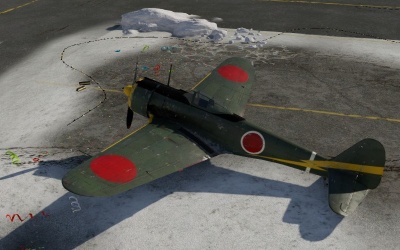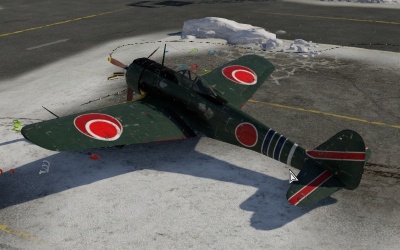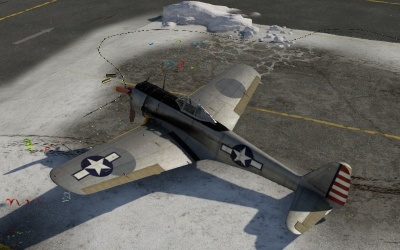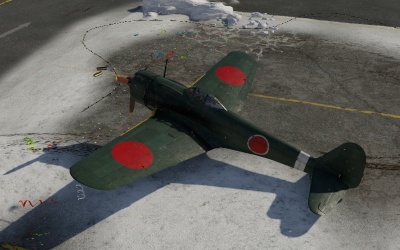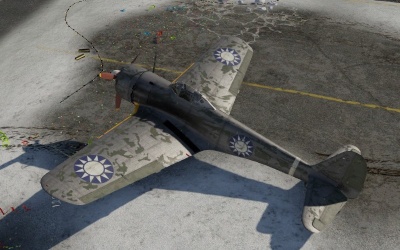User:DnaGonite/sandbox

Hey, just putting this comment here. I've been twisting the HTML allowed here on the wiki for the past couple of years and so far, this is the work I've made thus far. https://wiki.warthunder.com/index.php?title=User:U16697154&oldid=16302 If you take a look through the history tab on my page, you can also find all the other nonsense I've been up to. None of which are allowed on the main wiki for the foreseeable future unfortunately.
That being said, feel free to keep experimenting. - KornFlaks (talk) 17:15, 17 April 2019 (UTC)
Contents
Moving
Test
| Characteristics | Max Speed
(km/h at _,___ m) |
Max altitude
(metres) |
Turn time
(seconds) |
Rate of climb
(metres/second) |
Take-off run
(metres) | |||
|---|---|---|---|---|---|---|---|---|
| AB | RB | AB | RB | AB | RB | |||
| Stock | ___ | ___ | rowspan="2" | __._ | __._ | __._ | __._ | ___ |
| Upgraded | ___ | ___ | __._ | __._ | __._ | __._ | ||
Images
Collapse family
Rank II
Rank III
| |
Ki-43-IAfter the 10 improved prototypes were tested the Army settled on what they saw was the optimum configuration and requested that the production aircraft be equipped with the Nakajima Ha-25 engine. The final design entered production as the Ki-43-Ia (Army Type 1 Fighter Model 1A) with the first example completing production in April 1941. This model was soon replaced with the Ki-43-Ib (Army Type 1 Fighter Model 1B) which replaced one of the 7.7 mm machine guns with a 12.7 mm machine gun which was also soon replaced by the Ki-43-Ic (Army Type 1 Fighter Model 1C) which was equipped with two 12.7 mm machine gun.
| |
Ki-43-IIAfter some time in the field, the Ki-43 was to receive a major upgrade based on feedback from pilots, which included replacing the Ha-25 engine with the more powerful Ha-115 engine, a two stage supercharger, pilot armour, self-sealing fuel tanks and many more minor improvements. The first prototype of what was to become the Ki-43-II (Army Type 1 Fighter Model 2) was completed in February 1942.
| |
▃Ki-43-IIIn late 1942, the Australian Army managed to capture a intact example of a Ki-43 while fighting the Japanese Army in Papua New Guinea. It was quickly shipped back to Australia for testing where it ended up in the hands of the Technical Air Intelligence Unit who managed to repair it using parts from downed airplanes. It was painted in US livery and was used to test its performance against Allied planes. After testing by the Technical Air Intelligence Unit it was shipped to the United States for further evaluations.
| |
Ki-43-III otsuThe last major modification of the Ki-43 was done in 1944, combining the minor modifications of the IIa and IIb with the more powerful Nakajima Ha-115-II engine. These minor modifications over the Ki-43-II included a reduced wing-span (improving the plane's low and medium speed performance), increased pilot armour, improved oil cooler, and modified carburetor intake. This new Ki-43-IIIa (Army Type 1 Fighter Model 3A) entered production in October 1944 with approximately 1,000 being completed before the war ended.
| |
␗Ki-43-III koAfter the end of the war, a number of nations used the Ki-43, including the Indonesian People's Security Force who used them against the Dutch, and the French who used them against Communist forces in Indochina. One such post-war user was the Nationalist Chinese Air Forces who operated captured Ki-43 in the 6th group. These saw use against the Communist Chinese forces in the Chinese Civil War and 5 were eventually captured and used by the Chinese Communist Air Force until 1952.
| |
Mode family
| Choose mode | ||
|---|---|---|
| | ||
Rank II
- Ki-43-I - Includes all 3 Type I variants (Ko, Otsu & Hei) as modification
- Ki-43-II - Type II
- ▃Ki-43-II - USA-captured Type II
- ␗Ki-43-III ko - Chinese-captured Type IIIa (甲, Ko)
Rank III
- Ki-43-III otsu - Type IIIb (乙, Otsu)
Chronological order of use
Ki-43-IAfter the 10 improved prototypes were tested the Army settled on what they saw was the optimum configuration and requested that the production aircraft be equipped with the Nakajima Ha-25 engine. The final design entered production as the Ki-43-Ia (Army Type 1 Fighter Model 1A) with the first example completing production in April 1941. This model was soon replaced with the Ki-43-Ib (Army Type 1 Fighter Model 1B) which replaced one of the 7.7 mm machine guns with a 12.7 mm machine gun which was also soon replaced by the Ki-43-Ic (Army Type 1 Fighter Model 1C) which was equipped with two 12.7 mm machine gun.
|
Ki-43-IIAfter some time in the field, the Ki-43 was to receive a major upgrade based on feedback from pilots, which included replacing the Ha-25 engine with the more powerful Ha-115 engine, a two stage supercharger, pilot armour, self-sealing fuel tanks and many more minor improvements. The first prototype of what was to become the Ki-43-II (Army Type 1 Fighter Model 2) was completed in February 1942.
|
▃Ki-43-IIIn late 1942, the Australian Army managed to capture a intact example of a Ki-43 while fighting the Japanese Army in Papua New Guinea. It was quickly shipped back to Australia for testing where it ended up in the hands of the Technical Air Intelligence Unit who managed to repair it using parts from downed airplanes. It was painted in US livery and was used to test its performance against Allied planes. After testing by the Technical Air Intelligence Unit it was shipped to the United States for further evaluations.
|
Ki-43-III otsuThe last major modification of the Ki-43 was done in 1944, combining the minor modifications of the IIa and IIb with the more powerful Nakajima Ha-115-II engine. These minor modifications over the Ki-43-II included a reduced wing-span (improving the plane's low and medium speed performance), increased pilot armour, improved oil cooler, and modified carburetor intake. This new Ki-43-IIIa (Army Type 1 Fighter Model 3A) entered production in October 1944 with approximately 1,000 being completed before the war ended.
|
␗Ki-43-III koAfter the end of the war, a number of nations used the Ki-43, including the Indonesian People's Security Force who used them against the Dutch, and the French who used them against Communist forces in Indochina. One such post-war user was the Nationalist Chinese Air Forces who operated captured Ki-43 in the 6th group. These saw use against the Communist Chinese forces in the Chinese Civil War and 5 were eventually captured and used by the Chinese Communist Air Force until 1952.
|
Visual Editor breaks table for some reason
No idea what the cause is, but Visual Editor seems to randomly add a breakpoint at a random space. Current work-around is to use nbsp as space in table to prevent this.
May be unrelated, but VE didn't insert a return char between Attacker and Bomber nav-lines in cases where table broke.
For reference
I think it is possible to data-mine the tank optics zoom. In a tank BLK file if you divide 74 by the "zoomOutFov" or "zoomInFov" field that gives you the default and zoomed in magnification (it has a load of decimal points after it but when you round it to 1 d.p it is nearly always accurate, sometimes you will be out by 0.1 x though). Not sure the significance of 74, presumably it is the FoV of a 1x zoom or something. I worked this out by taking the standard zoom of the Challenger 2 (stated as x 4 in game), then multiplying it by the "zoomOutFov" field in the challenger 2 blk file to get 74. If I then pick other tanks in game which have a zoom specified and divide 74 by the "zoomOutFov" & "zoomInFoV" fields in their files the number you get nearly always rounds to what the zoom level was stated at in game. --Flame2512 (talk) 12:32, 28 April 2019 (UTC) [1]
Tech-tree fiddling
Inserting codeblocks in numbered lists
- Create a new file with *.blk extension
- Copy all this code below to the BLK file and use it as a template:
className:t="composit"
node{
type:t=""
name:t=""
tm:m=[[1.0, 0.0, 0.0] [0.0, 1.0, 0.0] [0.0, 0.0, 1.0] [0.0, 0.0, 0.0]]
}
- Step 3
Autoloader
| 90 mm Type 61 | Turret rotation speed (°/s) | Reloading rate (seconds) | |||||||||||
|---|---|---|---|---|---|---|---|---|---|---|---|---|---|
| Mode | Capacity | Vertical | Horizontal | Stabilizer | Stock | Upgraded | Full | Expert | Aced | Stock | Full | Expert | Aced |
| Arcade | 40 | -10°/+13° | ±180° | N/A | __._ | __._ | __._ | __._ | __._ | 6.00 | 6.00 | 6.00 | 6.00 |
| Realistic | __._ | __._ | __._ | __._ | __._ | ||||||||
| 90 mm Type 61 | Turret rotation speed (°/s) | Reloading rate (seconds) | ||||||||
|---|---|---|---|---|---|---|---|---|---|---|
| Mode | Capacity | Vertical | Horizontal | Stabilizer | Stock | Upgraded | Full | Expert | Aced | Autoloader |
| Arcade | 40 | -10°/+13° | ±180° | N/A | __._ | __._ | __._ | __._ | __._ | 6.00 |
| Realistic | __._ | __._ | __._ | __._ | __._ | |||||
| Mobility Characteristics | |||
|---|---|---|---|
| Game Mode | Upgrade Status | Maximum Speed (km/h) | |
| Forward | Reverse | ||
| AB | |||
| Upgraded | 66 | 30 | |
| RB/SB | |||
| Upgraded | 56 | 26 | |
| Mobility Characteristics | |||
|---|---|---|---|
| Game Mode | Upgrade Status | Maximum Speed (km/h) | |
| Forward | Reverse | ||
| AB | |||
| Upgraded | 66 | 30 | |
| RB/SB | |||
| Upgraded | 56 | 26 | |
| Mobility Characteristics | |||
|---|---|---|---|
| Game Mode | Upgrade Status | Maximum Speed (km/h) | |
| Forward | Reverse | ||
| AB | |||
| Upgraded | 66 | 30 | |
| RB/SB | |||
| Upgraded | 56 | 26 | |
| Mobility Characteristics | |||||
|---|---|---|---|---|---|
| Game Mode | Upgrade Status | Maximum Speed (km/h) | Turn Time (s) | Turn Radius (m) | |
| Forward | Reverse | ||||
| AB | Stock | 1 | ___ | ___ | ___ |
| Upgraded | 66 | 30 | ___ | ___ | |
| RB/SB | Stock | 1 | 1 | ___ | ___ |
| Upgraded | 56 | 26 | ~1 | ___ | |
Family Tree
| Correctness not included |
USA
|
||||||
|---|---|---|---|---|---|---|
Germany
|
||||||
USSR
|
||||||
Britain
|
||||||
Japan
|
||||||
China
|
||||||
Italy
|
||||||
France
|
Parser wing rip errors
| Vehicle | Parser wing rip speed |
|---|---|
| Spitfire F Mk IX (Example to show code works) |
774 |
| A6M6c | 0 |
| Bf 110 G-4 | 0 |
| ◐Bf 110 G-4 | 0 |
| Sea Vixen F.A.W. Mk.2 | 0 |
| F8U-2 | 0 |
| G8N1 | 0 |
| H8K2 | 0 |
| H8K3 | 0 |
| Hornet Mk.I | 0 |
| Hornet Mk.III | 0 |
| ␗I-16 Chung 28 | 0 |
| I-16 type 10 | 0 |
| ␗I-16 type 10 | 0 |
| ␗I-16 type 17 | 0 |
| I-16 type 18 | 0 |
| I-16 type 24 | 0 |
| I-16 type 27 | 0 |
| I-16 type 28 | 0 |
| I-16 type 5 | 0 |
| ␗I-16 type 5 | 0 |
| Ki-49-I | 0 |
| Ki-49-IIa | 0 |
| Ki-49-IIb | 0 |
| Ki-49-IIb/L | 0 |
| Mystere IVA | 0 |
| MiG-23M | 0 |
| ▂P-39K-1 | 0 |
| P-39N-0 | 0 |
| ▂Pokryshkin's P-39N-0 | 0 |
| ▂P-39Q-15 | 0 |
| ▄P-39Q-25 | 0 |
| P-39Q-5 | 0 |
| P-400 | 0 |
| P-40C | 0 |
| H-81A-2 | 0 |
| P-40E-1 | 0 |
| ␗P-40E-1 | 0 |
| P-40E-1 TD | 0 |
| ▂P-40E-1 | 0 |
| ▄P-40F-5 Lafayette | 0 |
| P-40F-10 | 0 |
| P-47N-15 | 0 |
| Sagittario 2 | 0 |
| Su-7BKL | 0 |
| Su-7BMK | 0 |
| Su-17M2 | 0 |
| Yak-28B | 0 |


